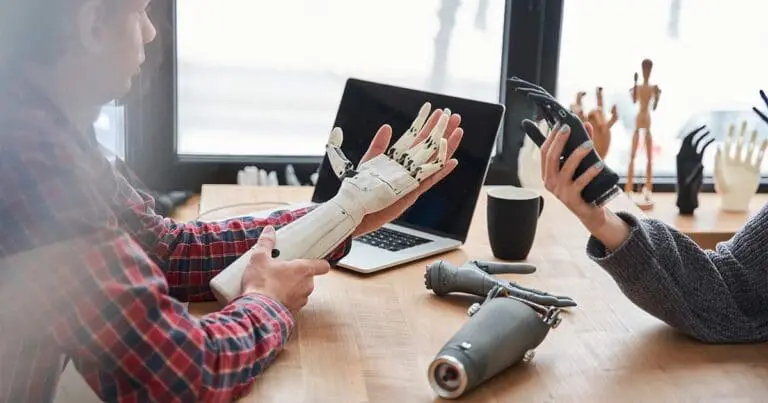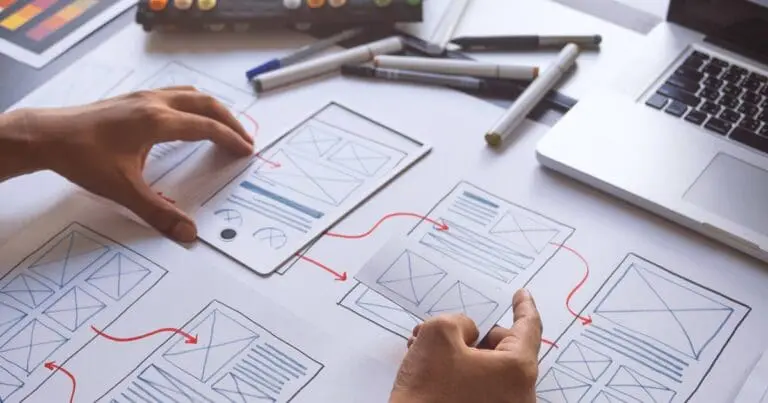The Importance of Specialized Talent in Bionic Prosthetic Innovations

In a world where science fiction often becomes a reality, one area of technological advancement continues to fascinate and astound: bionic prosthetics.
From the iconic bionic limbs of television’s “The Six Million Dollar Man” to the cutting-edge technology featured in films like “Iron Man,” the evolution of bionic prosthetics has captured our imaginations for decades.
But it’s not just the realms of fantasy that are pushing the boundaries of what’s possible — real-life advancements in prosthetic technology are revolutionizing the lives of people with disabilities.
Learn more about the future of bionics and delve into the intriguing journey of bionic prosthetics, exploring the latest advancements, their remarkable benefits, and the incredible talent behind their creation.
What are bionic prosthetics?
Bionic prosthetics, or bio-prosthetics, are artificial limbs that use bioengineering to replicate the functions of a lost limb, offering a greater degree of control and functionality to the user.
The roots of these advanced devices trace back to the post-World War II era, when significant investments were made in prosthetic technology to aid wounded soldiers.
Over the decades, advancements in technology and material science have transformed simple artificial limbs into sophisticated, programmable devices that can mimic natural body movements.
Today, bionic prosthetics incorporate cutting-edge technologies like robotics, AI, and neural interfaces, providing users with unprecedented levels of comfort, mobility, and independence.
Technological breakthroughs in bionics
Technological breakthroughs in bionics include myoelectric prosthetics, robotics, artificial intelligence (AI), and material science.
Myoelectric prosthetics in bionics
Myoelectric prosthetics represent one of the most significant leaps in bionic technology.
These devices utilize the electrical signals generated by the user’s residual limb muscles to control the movements of the prosthetic limb, offering a seamless, intuitive user experience.
Robotics in bionics
Robotics plays a critical role in the evolution of bionic prosthetics, enhancing precision, functionality, and control in these devices.
The incorporation of robotic elements in the design of prosthetics has enabled more lifelike movements, bridging the gap between artificial and natural limb functions.
Artificial Intelligence (AI) in boinics
Artificial Intelligence (AI) marks a pivotal turn in bionic prosthetics.
AI allows these devices to intuitively interpret the user’s intended movements, improving precision and adaptability.
By integrating machine learning algorithms, prosthetics can now learn and adapt to the user’s pattern and style, making the movement more fluid and natural.
Material science in bionics
Material science plays a crucial role in the development of bionic prosthetics, offering the potential to enhance durability, flexibility, and user comfort.
Cutting-edge materials such as carbon fiber composites are used to construct lightweight yet robust prosthetic limbs, mimicking the strength and resilience of natural bone structure.
Furthermore, advancements in 3D printing are revolutionizing the production process, making it possible to create bespoke prosthetics tailored specifically to the individual user’s needs and anatomy.
The talent behind bionic prosthetics innovation
The talent behind bionic prosthetics innovation includes interdisciplinary talent, key roles like biomedical engineers, and collaboration between the fields of science and tech.
Interdisciplinary talent in bionic prosthetics
The development of bionic prosthetics is an inherently interdisciplinary endeavor, requiring the combined expertise of various fields.
Professionals from the realms of biomechanics, material science, robotics, and neurology, along with software engineers specializing in artificial intelligence and machine learning, come together to drive the innovation.
This collaborative effort melds the boundaries of these distinct disciplines, fostering a unique environment that facilitates the creation of these ground-breaking devices.
Key roles needed in bionic prosthetics innovation
Biomedical engineers play a pivotal role in the realm of bionic prosthetics.
They combine engineering principles with medical science’s complexities to design and optimize these life-changing devices.
Roboticists and material scientists contribute significantly, the former by integrating sophisticated robotic mechanisms to enhance functionality and the latter by leveraging advanced materials to improve durability, flexibility, and user comfort.
Science and tech collaboration in bionic prosthetics innovation
The collaboration between medical professionals, engineers, and end-users is paramount in bionic prosthetics innovation.
Medical professionals provide essential insights into prosthetics’ anatomical and physiological requirements, while engineers employ these insights in their design and development process to ensure optimal functionality.
Additionally, end-users give valuable feedback on usability and comfort, driving improvements that further humanize these cutting-edge devices and enhance the quality of life for the wearers.
The current state of bionic prosthetics
- The latest bionic prosthetic technologies
- Features and capabilities of modern bionic limbs
- Sensory feedback and mind-control in prosthetics
- Improved quality of life for amputees
- Challenges and limitations
The latest bionic prosthetic technologies
The current landscape of bionic prosthetics is characterized by continuous innovation and technological refinement.
High-definition sensory feedback systems are being integrated, providing users with a sense of touch and spatial awareness previously thought impossible.
Meanwhile, the advent of brain-computer interfaces is heralding a new era.
Still in the developmental stages, the hope is that these interfaces will enable direct communication between the user’s brain and the prosthetic device, thus facilitating even more intuitive and natural movement.
Features and capabilities of modern bionic limbs
Modern bionic limbs come equipped with advanced capabilities that transform the lives of limb loss patients.
They can perform complex tasks like grasping objects, typing, or even playing musical instruments, offering users an opportunity to lead a normal life.
Furthermore, these limbs are equipped with sensors that can detect pressure and adjust grip accordingly, providing a sense of touch that closely mimics that of a biological limb.
Sensory feedback and mind-control in prosthetics
Sensory feedback in modern prosthetics represents a major breakthrough, enabling users to feel sensations such as pressure and temperature.
Meanwhile, mind-controlled prosthetics, powered by sophisticated brain-computer interfaces, are opening up new possibilities for intuitive control.
These advancements are poised to redefine the user experience, bringing us closer to the sci-fi dream of fully functional bionic limbs.
Improved quality of life for amputees
The advent of bionic prosthetics has profoundly impacted the psychological and social aspects of amputee’s lives, restoring a sense of normalcy and reducing the stigma associated with physical disabilities.
Users often report improved self-esteem and mental well-being, in large part due to the enhanced functionality and independence these prosthetics provide.
Furthermore, the ability to perform everyday tasks seamlessly facilitates social integration, easing the transition back into community life and creating a more inclusive society.
Challenges and limitations
Despite the impressive advancements in bionic prosthetics, technical challenges persist, particularly in the areas of design and functionality.
Integration of complex bioengineering concepts and individual customization often leads to difficulties in achieving a seamless and intuitive user experience with the prosthetic.
Furthermore, accessibility and affordability remain significant hurdles as the advanced technology involved often results in high production costs, making these life-changing devices unattainable for large portions of the population.
The future of bionic prosthetics innovation
Currently, bionic prosthetics stand at a pivotal juncture, integrating advanced materials, sensory feedback systems, and the beginnings of brain-computer interface technology. These elements collectively enhance functionality and have begun improving amputees’ quality of life.
However, it’s important to recognize that this field is still in a phase of active development. The future holds great promise, with emerging technologies offering the potential to refine the user experience further and address existing challenges.
Yet, achieving these advancements requires sustained research, time, and the dedicated efforts of professionals across various disciplines, including biomechanics, material science, robotics, and neurology.
The path ahead is one of collaborative innovation, where the combined expertise and ingenuity of these fields are crucial for realizing the full potential of bionic prosthetics and extending their transformative impact to a broader population.
Looking to hire top-tier Tech, Digital Marketing, or Creative Talent? We can help.
Every year, Mondo helps to fill over 2,000 open positions nationwide.
More articles about hiring and industry trends:
- Hiring During A Hiring Freeze: Turning Obstacles Into Opportunities
- Leadership Trends and Strategies for 2024
- Specialized AI Bots and the Evolution Beyond ChatGPT
- 24 Top In-Demand Tech and IT Jobs to Hire in 2024, with Salaries
- Fractional Executives & C-Suite Gig Work Shaping the Employment Landscape
- Harnessing the Power of Climate Tech to Drive Environmental Sustainability
- Staffing Strategies For Each Phase of the Business Cycle
- Tapping the Gig Economy: When It Makes Sense to Hire Contractors
- How Executive Recruiters Ease Your Hiring Process
- What to Do When You Have Urgent Hiring Needs
- Generative AI & Its Impact on the Job Market: It’s Not All Bad News



